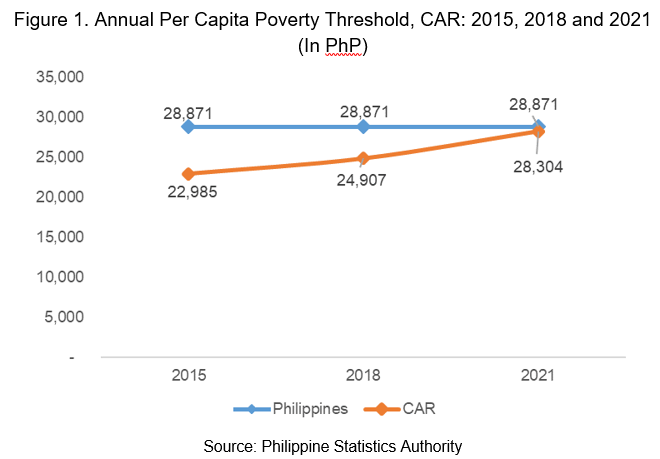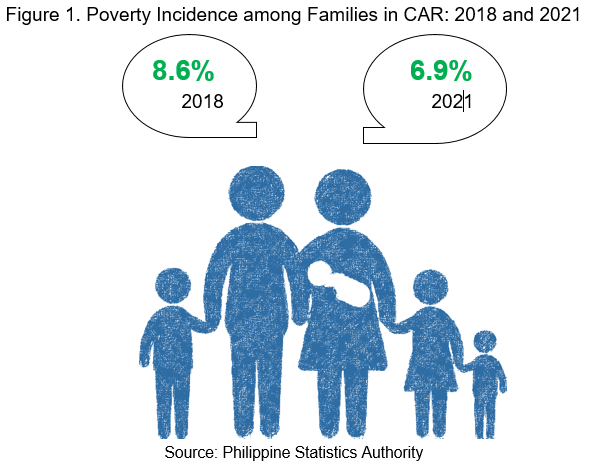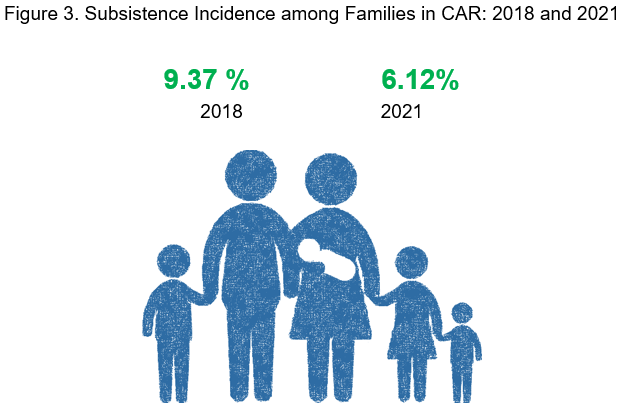The results of the Family Income and Expenditure Survey (FIES) in conducted 2021 are the main source of data for the estimation of the 2021 Full Year Official Poverty Statistics of the Philippines. The FIES is a nationwide survey of households undertaken every three years. It is the main source of data on family income and expenditure, which include among others, levels of consumption by item of expenditure as well as sources of income in cash and in kind. The results of FIES provide information on the levels of living and disparities in income of Filipino families, as well as their spending patterns.The results of the Family Income and Expenditure Survey (FIES) in conducted 2021 are the main source of data for the estimation of the 2021 Full Year Official Poverty Statistics of the Philippines. The FIES is a nationwide survey of households undertaken every three years. It is the main source of data on family income and expenditure, which include among others, levels of consumption by item of expenditure as well as sources of income in cash and in kind. The results of FIES provide information on the levels of living and disparities in income of Filipino families, as well as their spending patterns.
In CAR, at least PhP 11,793 monthly needed by a family of five to stay out of poverty
- Based on the results of 2021 full year poverty statistics, the per capita poverty threshold of CAR was estimated at PhP 28,304. The poverty threshold refers to the minimum income required for a family or individual to meet their basic food and non-food needs (e.g., clothing, housing, transportation, health, and education expenses). If the income falls below the threshold, the individual or family is considered poor.
- This means that a family of five needs at least PhP 11,793 per month, on the average, to meet their basic food and non-food needs. Compared to the 2018 poverty statistics, this was PhP 1,415 higher than the PhP 10,378 needed monthly by a family of five.
- The annual per capita poverty threshold in the region is lower than the national annual per capita poverty threshold by PhP 567.
Seven in one hundred families in CAR have income below poverty line
- In 2021, poverty incidence among families or proportion of poor Cordillerans whose per capita income is not sufficient to meet their basic food and non-food needs, was estimated at 6.9 percent. This was a difference of 1.7 percentage points from the poverty incidence of the region in 2018.
- The 6.9 poverty incidence was translated to an estimated 30,740 families in CAR who lived below the poverty threshold of PhP 28,304 in 2021.
- The region’s poverty incidence among families was lower compared to the national poverty incidence among families with 13.2 percent.
At least PhP 8,248 monthly needed by a family of five to meet basic food needs
- The annual per capita food threshold in CAR in 2021 was computed at PhP 19,795. This means that a family of five needs at least PhP 8,248 monthly income to meet their basic food needs. This was higher by PhP 984 compared to the PhP 7,264 monthly food threshold in 2018.
- Compared to the national annual per capita food threshold of PhP 20,111, the region’s annual per capita food threshold was lower by PhP 316.
About 14 out of 1,000 families in Cordillera are food poor
- The subsistence incidence among families in CAR decreased from the estimated 2.2 percent in 2018 to 1.4 percent in 2021. The 0.8 percentage point decrease was translated to less 3,250 food poor families or families living below the food threshold of PhP 19,795.
- Cordillera region’s subsistence incidence among families was lower compared to the national subsistence incidence among families of 3.9 percent.
Technical Notes
Family
a group of persons usually living together and composed of the head and other persons related to the head by blood, marriage or adoption. It includes both the nuclear and extended family.
Family Expenditures
The expenses or disbursements made by the family purely for personal consumption during the reference period. These include: - Total value of all items of consumption/expenditure bought on credit during the reference period as well as services availed of within the same period that have not been fully paid at the time of visit. - Value consumed from gifts, support, assistance or relief in goods and services received by the family from friends, relatives and imputed rent of owner-occupied dwelling unit. '- Gifts, support, assistance or relief in goods and services donated by the family to friends, relatives and others like tithes, contribution to church, etc. - Imputed value of goods/ services received as fringe benefits from employer or part of the salaries/wages of employed family members.
Family Income
The primary income and receipts from other sources received by all family members during the reference period, as participants in any economic activity or as recipients of transfers, pensions, grants, interests, food and non-food items received as gifts by the family. Primary income includes: - Salaries and wages from employment - Commissions, tips, bonuses, family and clothing allowance, transportation and representation allowance and honoraria - Other forms of compensation and net receipts derived from the operation of family-operated enterprises/activities and the practice of a profession or trade Income from other sources includes: - Imputed rental values of owner-occupied dwelling units - Interests - Rentals including landowner’s share of agricultural products - Pensions, royalties and dividends from investments - Gifts, support in any form (physical, material and financial) and the value of food and non-food items received as gifts by the family (as well as the imputed value of services rendered free of charge to the family). - Cash received out of salaries/wages and other sources of income of a family member who is a contract worker abroad and also cash receipts sent by a family member/relative of the household with a status of residency abroad other than that of a contract worker - Receipts from family sustenance activities, which are not considered as family operated enterprise.
Food threshold (FT)
the minimum income/expenditure required for a family/individual to meet the basic food needs, which satisfies the nutritional requirements for economically necessary and socially desirable physical activities.
Poverty incidence (PI)
the proportion of families/individuals with per capita income/expenditure less than the per capita poverty threshold to the total number of families/individuals
Poverty threshold (PT)
the minimum income/expenditure required for a family/individual to meet the basic food and non-food requirements
_____________________________________________________________________________





